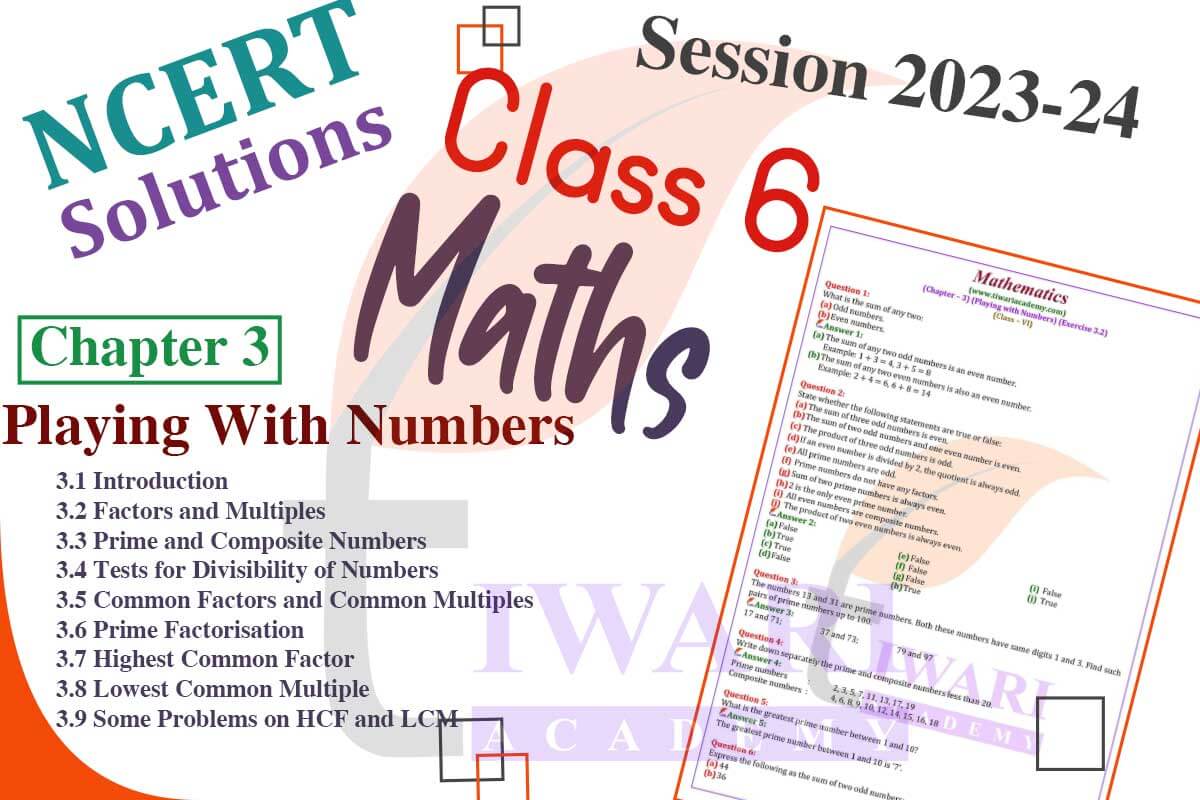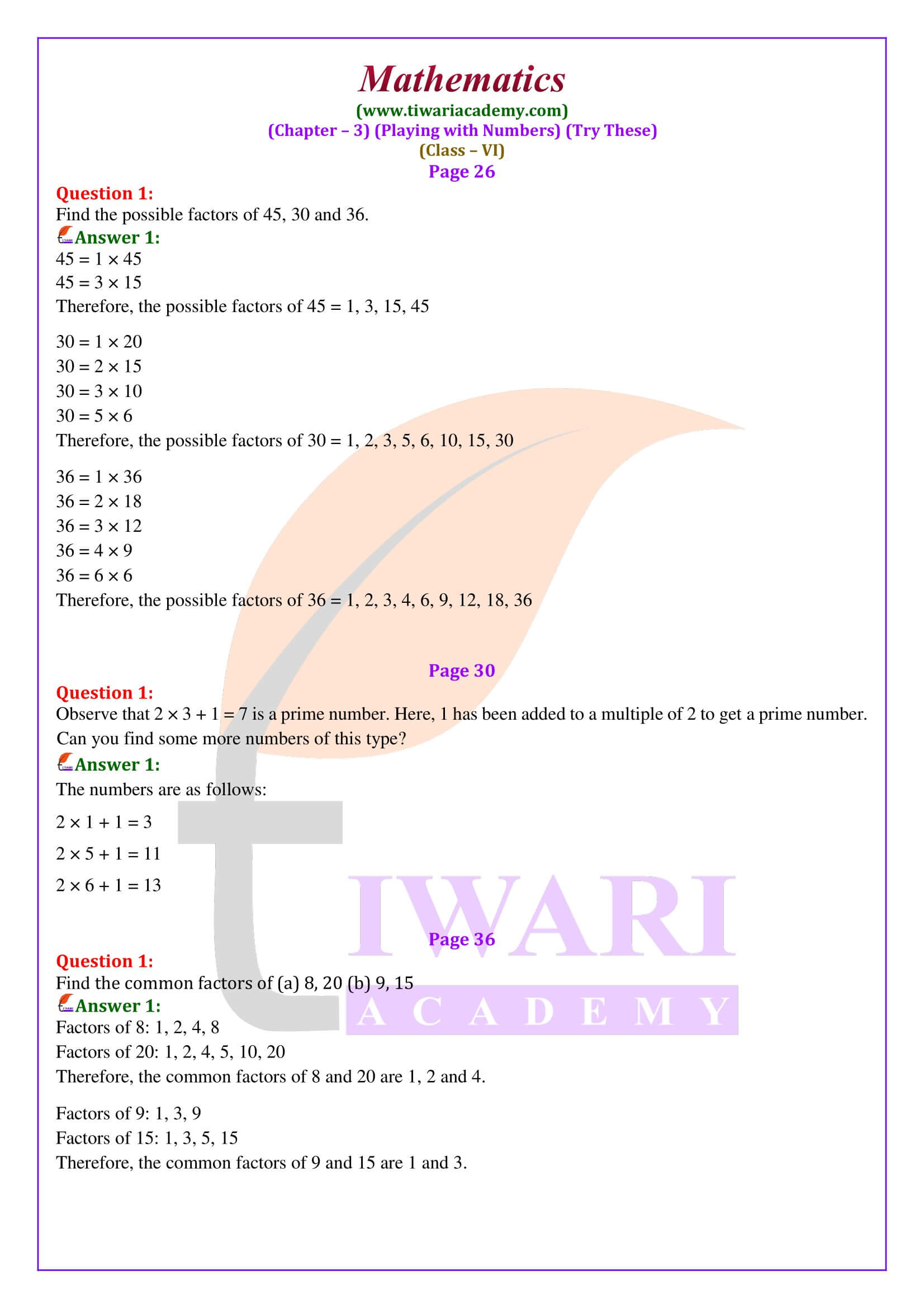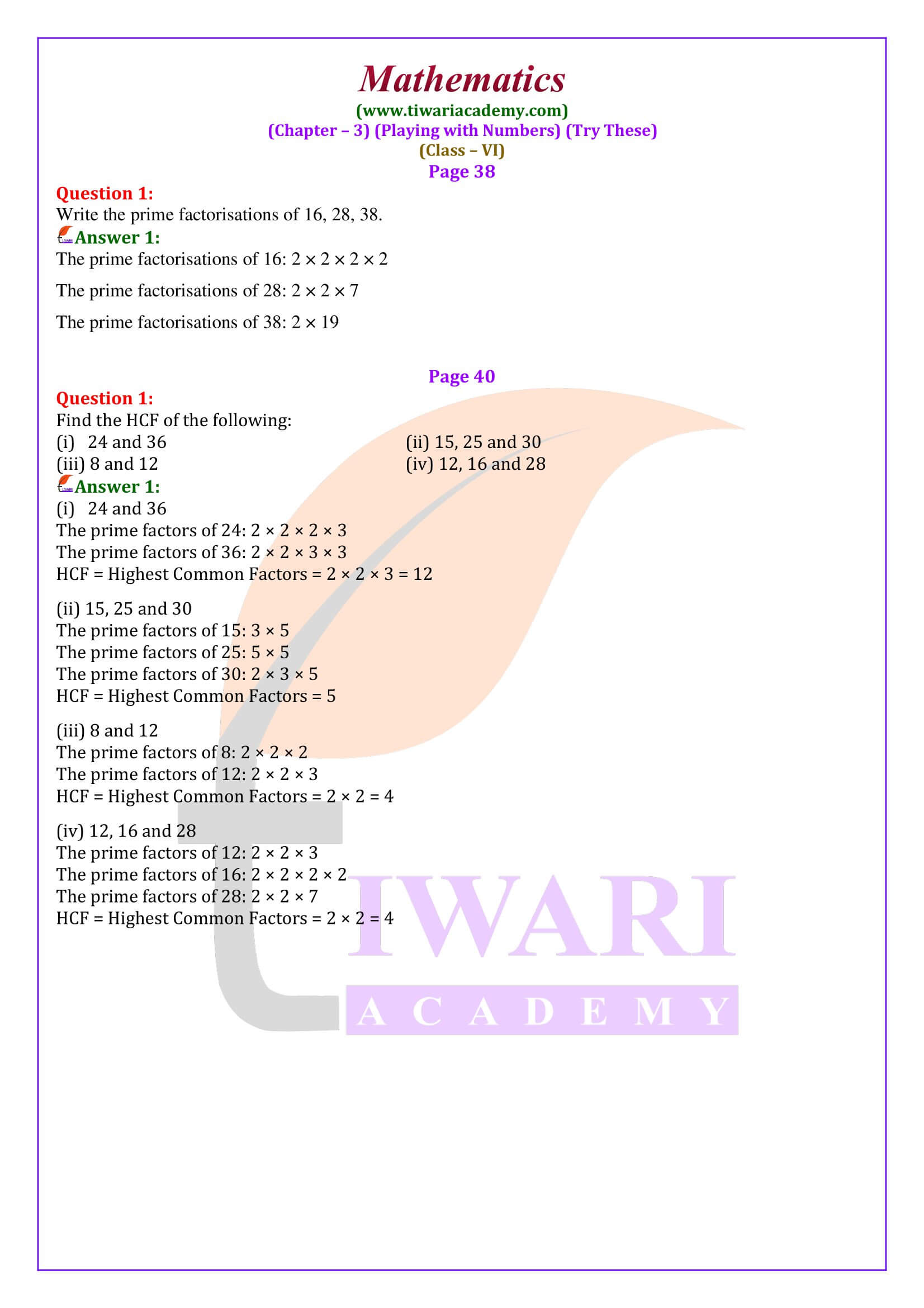NCERT Solutions for Class 6 Maths Chapter 3 Playing With Numbers and Class 6 Maths Chapter 3 Try These Solutions with Practice Tests in Hindi and English Medium updated and modified for academic Session 2025-26. Students of class 6 can get the revised solutions of chapter 3 here, which is based on latest NCERT book published according to new curriculum for 2025-26.
Class 6th Maths Chapter 3 Solutions for CBSE and State Boards
Class 6 Maths Chapter 3 Practice Test
6th Maths Chapter 3 Test 1
6th Maths Chapter 3 Test 2
6th Maths Chapter 3 Test 3
6th Maths Chapter 3 Test 4
6th Maths Chapter 3 Test 5
6th Maths Chapter 3 Test 6
6th Maths Chapter 3 Solutions in Hindi Medium
- Class 6 Maths Exercise 3.1 in Hindi
- Class 6 Maths Exercise 3.2 in Hindi
- Class 6 Maths Exercise 3.3 in Hindi
- Class 6 Maths Exercise 3.4 in Hindi
- Class 6 Maths Exercise 3.5 in Hindi
- Class 6 Maths Exercise 3.6 in Hindi
- Class 6 Maths Exercise 3.7 in Hindi
- Class 6 Maths Chapter 3 NCERT Book
- Class 6 Maths Solutions Page
- Class 6 all Subjects Solutions

| Class: 6 | Mathematics |
| Chapter 3: | Playing With Numbers |
| Number of Exercises: | 7 (Seven) |
| Study Material: | NCERT Exercises Solution |
| Content Type: | Online Text, Images and Videos |
| Academic Session: | 2025-26 |
| Medium: | Hindi and English |
NCERT Solutions for Class 6 Maths Chapter 3
Class VI Mathematics Exercise 3.1, Exercise 3.2, Exercise 3.3, Exercise 3.4, Exercise 3.5, Exercise 3.6 and Exercise 3.7 in English and Hindi Medium for session 2025-26. Solutions of Prashnavali 3.1, Prashnavali 3.2, Prashnavali 3.3, Prashnavali 3.4, Prashnavali 3.5, Prashnavali 3.6 and Prashnavali 3.7 in Hindi Medium in PDF file format as well as study online without downloading. Video Format Solution with explanation of 6 Maths NCERT Textbook Chapter 3 Playing With Numbers is also available in English Medium free to download. Download Class 6 Maths App for Offline use.

Download Class 6 Maths Chapter 3 Solutions in PDF Format
NCERT Solutions for Class 6 Maths Chapter 3 in Hindi Medium and English Medium are given below, free to use. All the solutions are updated for new academic session based on latest books from NCERT official website (https://ncert.nic.in/).
About 6 Maths Chapter 3 Solutions
In 6 Maths Chapter 3 Playing With Numbers, we will study about the factors and multiples of numbers. A factor of a number is an exact divisor of that number. The following the some facts about a factor:
1 is a factor of every number.
Every number is a factor of itself.
Every factor of a number is an exact divisor of that number.
Every factor is less than or equal to the given number.
Number of factors of a given number are finite.
Following facts are related to a multiple of a number:
Every multiple of a number is greater than or equal to that number.
The number of multiples of a given number is infinite.
Every number is a multiple of itself.
Perfect Number: A number for which sum of all its factors is equal to twice the number is called a perfect number. The numbers 6 are perfect numbers as 6 = 1 + 2 + 3 and 28 = 1 + 2 + 4 + 7 + 14.
Important Questions on Class 6 Maths Chapter 3
Write all the factors of 24.
24 = 1 x 24 = 2 x 12 = 3 x 8 = 4 x 6 = 6 x 4 Factors of 24 = 1, 2, 3, 4, 6, 12, 24
Write first five multiples of 5.
5 x 1 = 5, 5 x 2 = 10, 5 x 3 = 15, 5 x 4 = 20, 5 x 5 = 25 First five multiples of 5 are 5, 10, 15, 20, 25.
Find all the multiples of 9 up to 100.
Multiples of 9 up to 100 are: 9, 18, 27, 36, 45, 54, 63, 72, 81, 90, 99.
Using divisibility test, determine whether 5445 is divisible by 11?
5445 Sum of the digits at odd places = 4 + 5 = 9 Sum of the digits at even places = 4 + 5 = 9 Difference of both sums = 9 – 9 = 0 Since the difference is 0, therefore, the number is divisible by 11.
Which factors are not included in the prime factorization of a composite number?
1 is the factor which is not included in the prime factorization of a composite number.
Write the greatest 4-digit number and express it in terms of its prime factors.
The greatest 4-digit number = 9999 The prime factors of 9999 are 3 × 3 × 11 × 101.
Write the smallest 5-digit number and express it in terms of its prime factors.
The smallest five digit number is 10000. The prime factors of 10000 are 2 × 2 × 2 × 2 × 5 × 5 × 5 × 5.
The product of three consecutive numbers is always divisible by 6. Verify this statement with the help of some examples.
Among the three consecutive numbers, there must be one even number and one multiple of 3. Thus, the product must be multiple of 6. Example: (i) 2 x 3 x 4 = 24 (ii) 4 x 5 x 6 = 120
Renu purchases two bags of fertilizer of weights 75 kg and 69 kg. Find the maximum value of weight which can measure the weight of the fertilizer exact number of times.
For finding maximum weight, we have to find H.C.F. of 75 and 69. Factors of 75 = 3 x 5 x 5 Factors of 69 = 3 x 69 H.C.F. = 3 Therefore the required weight is 3 kg.
The sum of two consecutive odd numbers is always divisible by 4. Verify this statement with the help of some examples.
3 + 5 = 8 and 8 is divisible by 4. 5 + 7 = 12 and 12 is divisible by 4. 7 + 9 = 16 and 16 is divisible by 4. 9 + 11 = 20 and 20 is divisible by 4.
I am the smallest number, having four different prime factors. Can you find me?
The smallest four prime numbers are 2, 3, 5 and 7. Hence, the required number is 2 x 3 x 5 x 7 = 210
The length, breadth and height of a room are 825 cm, 675 cm and 450 cm respectively. Find the longest tape which can measure the three dimensions of the room exactly.
The measurement of longest tape = H.C.F. of 825 cm, 675 cm and 450 cm.
Factors of 825 = 3 x 5 x 5 x 11
Factors of 675 = 3 x 5 x 5 x 3 x 3
Factors of 450 = 2 x 3 x 3 x 5 x 5
H.C.F. = 3 x 5 x 5 = 75 cm
Therefore, the longest tape is 75 cm.

Feedback and Suggestions
Sometime all the PDF fail to load for online use. In that case you have to REFRESH this page to gel all the Solutions. We are working to provide the best NCERT Book Solutions to all the students without any charge. That is why we need not only your support but feedback and suggestions also.
Is chapter 3 of class 6th Maths interesting?
Yes, chapter 3 of class 6th Maths is nice and interesting. In this chapter, students will study many interesting topics like:
- Factors and Multiples
- Perfect numbers
- Prime and Composite Numbers
- Even and Odd numbers
- Tests for Divisibility of Numbers
- Common Factors and Common Multiples
- Some More Divisibility Rules
- Prime Factorisation
- Highest Common Factor
- Lowest Common Multiple
- Some Problems on HCF and LCM.
How many exercises are there in chapter 3 of class 6 Maths?
There are 7 exercises in chapter 3 of class 6th Maths.
In the first exercise (Ex 3.1), there are only 4 questions.
In the second exercise (Ex 3.2), there are 12 questions.
The third exercise (Ex 3.3) contains 6 questions.
The fourth exercise (Ex 3.4) has 7 questions.
There are 12 questions in the fifth exercise (Ex 3.5).
The sixth exercise (Ex 3.6) has only 3 questions.
There are 11 questions in the seventh exercise (Ex 3.7).
The sixth exercise has the minimum number of questions.
Is chapter 3 of grade 6th Maths simple to solve and understand?
Chapter 3 of grade 6th Maths is simple to solve and understand. All questions and examples of this chapter are good, straightforward, and logical. Students enjoy doing this chapter. Only in section 3.10 of chapter 3 of class 6th Maths, students face a little problem.
Is chapter 3 of class 6th Maths useful in higher classes?
Yes, chapter 3 of class 6th Maths is useful in higher classes. Students can’t skip this chapter. Chapter 3 is not only useful in school, but it is helpful in graduation also if students take Maths in their graduation.





